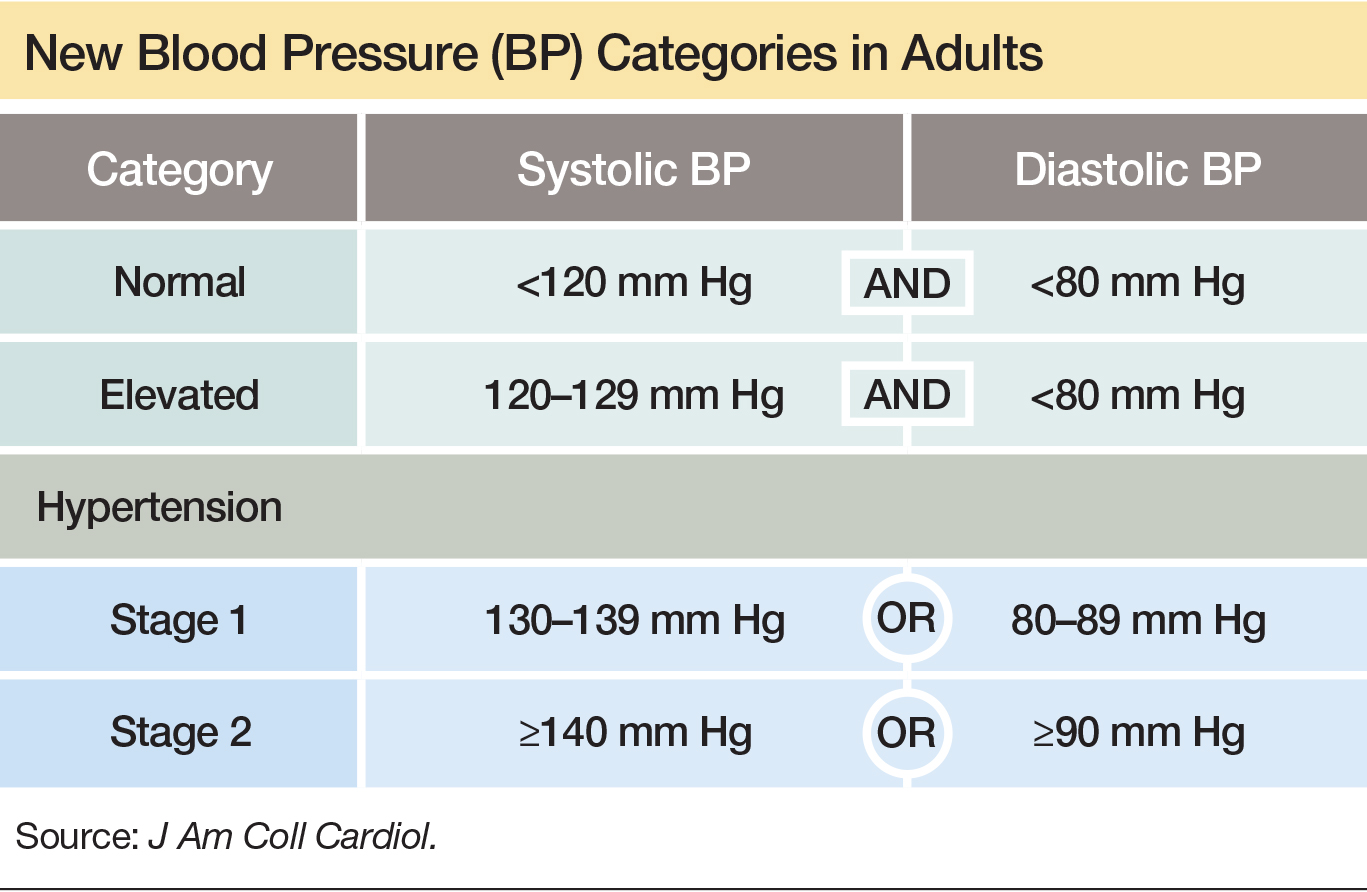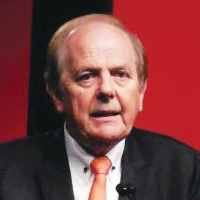User login
ANAHEIM, CA—Thirty million Americans became hypertensive overnight with the introduction of a new high blood pressure guideline from the American College of Cardiology (ACC) and American Heart Association (AHA).
The guideline changes the definition of adult hypertension from the long-standing threshold of 140/90 mm Hg to 130/80 mm Hg. As a result, adult prevalence of hypertension in the United States increased from roughly 32% to 46%, bringing the national hypertensive population to 103 million. The guideline was presented at the AHA’s 2017 Scientific Sessions and published in the Journal of the American College of Cardiology and Hypertension.
In addition to those with hypertension, another 12% of American adults have what the new guideline calls elevated blood pressure—a systolic pressure of 120–129 mm Hg with a diastolic pressure of less than 80 mm Hg. This group warrants lifestyle interventions to arrest progression, according to the guideline. In selected subgroups, the prevalence of hypertension is even greater. Among African American men and women, for example, approximately 55% have hypertension under the new guideline. And among men and women ages 65 and older, more than three-quarters now have hypertension.
Goal Is to Transform Care
Beyond the guideline’s epidemiologic implications, it includes 106 recommendations for preventing, detecting, evaluating, and managing adult hypertension. The guideline addresses every aspect of blood pressure in American medical practice, from how it is measured to how medical systems can try to ensure that every person with a blood pressure outside the redefined limits gets a comprehensive package of interventions.
The guideline includes a risk-based approach to making treatment decisions, a reduced treatment target of less than 130/80 mm Hg, and strategies to improve treatment efficacy, said Paul K. Whelton, MD, chair of the guidelines task force and Professor of Global Health at Tulane University in New Orleans.
Some of the recommendations represent “seismic changes,” said Lawrence J. Appel, MD, Professor of Epidemiology at Johns Hopkins University in Baltimore, who was not involved in writing the guideline. In particular, the new classification of stage 1 hypertension, the emphasis on using out-of-office blood pressure measurement to confirm a diagnosis, and having the same blood pressure goal of less than 130/80 mm Hg for all patients with hypertension, regardless of age, as long as they remain ambulatory and community dwelling, are major changes, he said.
One Goal for All Adults
“The systolic blood pressure goal for older people has gone from 140 mm Hg to 150 mm Hg and now to 130 mm Hg” within a few years, commented Dr. Appel. In fact, the guideline simplifies the treatment goal to less than 130/80 mm Hg for all adults, including patients with diabetes, those with chronic kidney disease, and the elderly.
“It will be clearer and easier now that everyone should be less than 130/80 mm Hg. You will not need to remember a second target,” said Sandra J. Taler, MD, a nephrologist and Professor of Medicine at the Mayo Clinic in Rochester, Minnesota, and a member of the guidelines task force. “Some people may be upset that we changed the rules on them. They had normal blood pressure yesterday, and today it is high. But it is a good awakening, especially for using lifestyle interventions.”
Preferred Intervention: Lifestyle, Not Drugs
The guideline cites lifestyle optimization as the cornerstone of intervention for everyone and as the only endorsed intervention for patients with hypertens
The guideline may encourage “a recommitment to lifestyle changes” for preventing and managing hypertension, said the task force’s vice chair, Robert M. Carey, MD, Professor of Medicine at the University of Virginia in Charlottesville.

Team-Based Care Is Essential
The guideline emphasizes a team-based management approach that includes nurses, nurse practitioners, pharmacists, dietitians, and other clinicians, allowing for more frequent and focused care. Dr. Whelton and others cited the VA Health System and Kaiser-Permanente as operating team-based and system-driven blood pressure management programs that have resulted in control rates for more than 90% of patients with hypertension. The team-based approach is a key component of Target:BP, a program founded by the AHA and American Medical Association to promote implementation of the new guideline, Dr. Carey said. Another systems recommendation in the guideline is that every patient with hypertension should have a “clear, detailed, and current evidence-based plan of care.”
“Using nurse practitioners, physician assistants, and pharmacists has been shown to improve blood pressure levels,” and health systems that take this approach have had “great success,” commented Donald M. Lloyd-Jones, MD, Professor and Chairman of Preventive Medicine at Northwestern University in Chicago, who was not part of the guidelines task force. Financial penalties and incentives from payers exist to push for higher levels of blood pressure control, and the alignment of financial and health incentives should result in big changes, Dr. Lloyd-Jones predicted.
—Mitchel L. Zoler
Suggested Reading
Whelton PK, Carey RM, Aronow WS, et al. 2017 ACC/AHA/AAPA/ABC/ACPM/AGS/APhA/ASH/ASPC/NMA/PCNA Guideline for the prevention, detection,evaluation, and management of high bood pressure in adults: a report of the American College of Cardiology/American Heart Association Task Force on Clinical Practice Guidelines. J Am Coll Cardiol. 2017 Nov 7 [Epub ahead of print].
ANAHEIM, CA—Thirty million Americans became hypertensive overnight with the introduction of a new high blood pressure guideline from the American College of Cardiology (ACC) and American Heart Association (AHA).
The guideline changes the definition of adult hypertension from the long-standing threshold of 140/90 mm Hg to 130/80 mm Hg. As a result, adult prevalence of hypertension in the United States increased from roughly 32% to 46%, bringing the national hypertensive population to 103 million. The guideline was presented at the AHA’s 2017 Scientific Sessions and published in the Journal of the American College of Cardiology and Hypertension.
In addition to those with hypertension, another 12% of American adults have what the new guideline calls elevated blood pressure—a systolic pressure of 120–129 mm Hg with a diastolic pressure of less than 80 mm Hg. This group warrants lifestyle interventions to arrest progression, according to the guideline. In selected subgroups, the prevalence of hypertension is even greater. Among African American men and women, for example, approximately 55% have hypertension under the new guideline. And among men and women ages 65 and older, more than three-quarters now have hypertension.
Goal Is to Transform Care
Beyond the guideline’s epidemiologic implications, it includes 106 recommendations for preventing, detecting, evaluating, and managing adult hypertension. The guideline addresses every aspect of blood pressure in American medical practice, from how it is measured to how medical systems can try to ensure that every person with a blood pressure outside the redefined limits gets a comprehensive package of interventions.
The guideline includes a risk-based approach to making treatment decisions, a reduced treatment target of less than 130/80 mm Hg, and strategies to improve treatment efficacy, said Paul K. Whelton, MD, chair of the guidelines task force and Professor of Global Health at Tulane University in New Orleans.
Some of the recommendations represent “seismic changes,” said Lawrence J. Appel, MD, Professor of Epidemiology at Johns Hopkins University in Baltimore, who was not involved in writing the guideline. In particular, the new classification of stage 1 hypertension, the emphasis on using out-of-office blood pressure measurement to confirm a diagnosis, and having the same blood pressure goal of less than 130/80 mm Hg for all patients with hypertension, regardless of age, as long as they remain ambulatory and community dwelling, are major changes, he said.
One Goal for All Adults
“The systolic blood pressure goal for older people has gone from 140 mm Hg to 150 mm Hg and now to 130 mm Hg” within a few years, commented Dr. Appel. In fact, the guideline simplifies the treatment goal to less than 130/80 mm Hg for all adults, including patients with diabetes, those with chronic kidney disease, and the elderly.
“It will be clearer and easier now that everyone should be less than 130/80 mm Hg. You will not need to remember a second target,” said Sandra J. Taler, MD, a nephrologist and Professor of Medicine at the Mayo Clinic in Rochester, Minnesota, and a member of the guidelines task force. “Some people may be upset that we changed the rules on them. They had normal blood pressure yesterday, and today it is high. But it is a good awakening, especially for using lifestyle interventions.”
Preferred Intervention: Lifestyle, Not Drugs
The guideline cites lifestyle optimization as the cornerstone of intervention for everyone and as the only endorsed intervention for patients with hypertens
The guideline may encourage “a recommitment to lifestyle changes” for preventing and managing hypertension, said the task force’s vice chair, Robert M. Carey, MD, Professor of Medicine at the University of Virginia in Charlottesville.

Team-Based Care Is Essential
The guideline emphasizes a team-based management approach that includes nurses, nurse practitioners, pharmacists, dietitians, and other clinicians, allowing for more frequent and focused care. Dr. Whelton and others cited the VA Health System and Kaiser-Permanente as operating team-based and system-driven blood pressure management programs that have resulted in control rates for more than 90% of patients with hypertension. The team-based approach is a key component of Target:BP, a program founded by the AHA and American Medical Association to promote implementation of the new guideline, Dr. Carey said. Another systems recommendation in the guideline is that every patient with hypertension should have a “clear, detailed, and current evidence-based plan of care.”
“Using nurse practitioners, physician assistants, and pharmacists has been shown to improve blood pressure levels,” and health systems that take this approach have had “great success,” commented Donald M. Lloyd-Jones, MD, Professor and Chairman of Preventive Medicine at Northwestern University in Chicago, who was not part of the guidelines task force. Financial penalties and incentives from payers exist to push for higher levels of blood pressure control, and the alignment of financial and health incentives should result in big changes, Dr. Lloyd-Jones predicted.
—Mitchel L. Zoler
Suggested Reading
Whelton PK, Carey RM, Aronow WS, et al. 2017 ACC/AHA/AAPA/ABC/ACPM/AGS/APhA/ASH/ASPC/NMA/PCNA Guideline for the prevention, detection,evaluation, and management of high bood pressure in adults: a report of the American College of Cardiology/American Heart Association Task Force on Clinical Practice Guidelines. J Am Coll Cardiol. 2017 Nov 7 [Epub ahead of print].
ANAHEIM, CA—Thirty million Americans became hypertensive overnight with the introduction of a new high blood pressure guideline from the American College of Cardiology (ACC) and American Heart Association (AHA).
The guideline changes the definition of adult hypertension from the long-standing threshold of 140/90 mm Hg to 130/80 mm Hg. As a result, adult prevalence of hypertension in the United States increased from roughly 32% to 46%, bringing the national hypertensive population to 103 million. The guideline was presented at the AHA’s 2017 Scientific Sessions and published in the Journal of the American College of Cardiology and Hypertension.
In addition to those with hypertension, another 12% of American adults have what the new guideline calls elevated blood pressure—a systolic pressure of 120–129 mm Hg with a diastolic pressure of less than 80 mm Hg. This group warrants lifestyle interventions to arrest progression, according to the guideline. In selected subgroups, the prevalence of hypertension is even greater. Among African American men and women, for example, approximately 55% have hypertension under the new guideline. And among men and women ages 65 and older, more than three-quarters now have hypertension.
Goal Is to Transform Care
Beyond the guideline’s epidemiologic implications, it includes 106 recommendations for preventing, detecting, evaluating, and managing adult hypertension. The guideline addresses every aspect of blood pressure in American medical practice, from how it is measured to how medical systems can try to ensure that every person with a blood pressure outside the redefined limits gets a comprehensive package of interventions.
The guideline includes a risk-based approach to making treatment decisions, a reduced treatment target of less than 130/80 mm Hg, and strategies to improve treatment efficacy, said Paul K. Whelton, MD, chair of the guidelines task force and Professor of Global Health at Tulane University in New Orleans.
Some of the recommendations represent “seismic changes,” said Lawrence J. Appel, MD, Professor of Epidemiology at Johns Hopkins University in Baltimore, who was not involved in writing the guideline. In particular, the new classification of stage 1 hypertension, the emphasis on using out-of-office blood pressure measurement to confirm a diagnosis, and having the same blood pressure goal of less than 130/80 mm Hg for all patients with hypertension, regardless of age, as long as they remain ambulatory and community dwelling, are major changes, he said.
One Goal for All Adults
“The systolic blood pressure goal for older people has gone from 140 mm Hg to 150 mm Hg and now to 130 mm Hg” within a few years, commented Dr. Appel. In fact, the guideline simplifies the treatment goal to less than 130/80 mm Hg for all adults, including patients with diabetes, those with chronic kidney disease, and the elderly.
“It will be clearer and easier now that everyone should be less than 130/80 mm Hg. You will not need to remember a second target,” said Sandra J. Taler, MD, a nephrologist and Professor of Medicine at the Mayo Clinic in Rochester, Minnesota, and a member of the guidelines task force. “Some people may be upset that we changed the rules on them. They had normal blood pressure yesterday, and today it is high. But it is a good awakening, especially for using lifestyle interventions.”
Preferred Intervention: Lifestyle, Not Drugs
The guideline cites lifestyle optimization as the cornerstone of intervention for everyone and as the only endorsed intervention for patients with hypertens
The guideline may encourage “a recommitment to lifestyle changes” for preventing and managing hypertension, said the task force’s vice chair, Robert M. Carey, MD, Professor of Medicine at the University of Virginia in Charlottesville.

Team-Based Care Is Essential
The guideline emphasizes a team-based management approach that includes nurses, nurse practitioners, pharmacists, dietitians, and other clinicians, allowing for more frequent and focused care. Dr. Whelton and others cited the VA Health System and Kaiser-Permanente as operating team-based and system-driven blood pressure management programs that have resulted in control rates for more than 90% of patients with hypertension. The team-based approach is a key component of Target:BP, a program founded by the AHA and American Medical Association to promote implementation of the new guideline, Dr. Carey said. Another systems recommendation in the guideline is that every patient with hypertension should have a “clear, detailed, and current evidence-based plan of care.”
“Using nurse practitioners, physician assistants, and pharmacists has been shown to improve blood pressure levels,” and health systems that take this approach have had “great success,” commented Donald M. Lloyd-Jones, MD, Professor and Chairman of Preventive Medicine at Northwestern University in Chicago, who was not part of the guidelines task force. Financial penalties and incentives from payers exist to push for higher levels of blood pressure control, and the alignment of financial and health incentives should result in big changes, Dr. Lloyd-Jones predicted.
—Mitchel L. Zoler
Suggested Reading
Whelton PK, Carey RM, Aronow WS, et al. 2017 ACC/AHA/AAPA/ABC/ACPM/AGS/APhA/ASH/ASPC/NMA/PCNA Guideline for the prevention, detection,evaluation, and management of high bood pressure in adults: a report of the American College of Cardiology/American Heart Association Task Force on Clinical Practice Guidelines. J Am Coll Cardiol. 2017 Nov 7 [Epub ahead of print].

